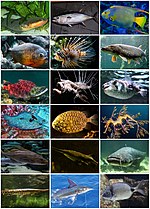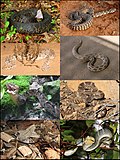modes are distinguished from viviparity, which covers all the modes that result in live birth: Histotrophic viviparity: the zygotes develop in the female's...
17 KB (1,975 words) - 20:04, 23 October 2024
Ovoviviparity (redirect from Aplacental viviparity)
first two of these modes were categorized under histotroph viviparity, or aplacental viviparity. The young of ovoviviparous amphibians are sometimes born...
7 KB (791 words) - 21:22, 21 April 2024
vipers exhibit ovoviviparity. The more developed form of viviparity is called placental viviparity; mammals are the best example, but it has also evolved...
15 KB (1,633 words) - 00:34, 15 November 2024
Adenotrophic viviparity means "gland fed, live birth". This is the reproductive mode of insects such as tsetse flies (Glossinidae), keds (Hippoboscidae)...
3 KB (325 words) - 04:06, 19 June 2024
parent; histotrophic viviparity, where the zygotes develop in the female's oviducts, but are fed on other tissues; and hemotrophic viviparity, where the developing...
5 KB (645 words) - 02:05, 15 June 2023
Hemiptera (section Parthenogenesis and viviparity)
Hemiptera (/hɛˈmɪptərə/; from Ancient Greek hemipterus 'half-winged') is an order of insects, commonly called true bugs, comprising over 80,000 species...
68 KB (6,825 words) - 15:21, 17 November 2024
oviparous, with egg-casings that resist evaporation of moisture. Ovo-viviparity is where the zygote is retained in the adult's body but there are no trophic...
39 KB (4,476 words) - 04:43, 20 November 2024
Viviparous lizard (section Viviparity and oviparity)
Surget-Groba, Yann (17 January 2006). "Multiple origins of viviparity, or reversal from viviparity to oviparity? The European common lizard (Zootoca vivipara...
30 KB (3,373 words) - 00:00, 28 October 2024
Shark (section Viviparity)
shark, and swellshark. Viviparity is the gestation of young without the use of a traditional egg, and results in live birth. Viviparity in sharks can be placental...
143 KB (14,302 words) - 00:49, 19 November 2024
condition. The oldest case of viviparity in ray-finned fish is found in Middle Triassic species of †Saurichthys. Viviparity is relatively rare and is found...
48 KB (3,811 words) - 20:40, 21 November 2024
Fish reproduction (section Viviparity)
classifications – ovuliparity, oviparity, ovo-viviparity, histotrophic viviparity and hemotrophic viviparity. Ovuliparity means the female lays unfertilised...
47 KB (5,722 words) - 21:45, 28 October 2024
young are nourished by egg yolk. There are two types of viviparity in fish. In histotrophic viviparity, the zygotes develop in the female's oviducts, but she...
35 KB (3,536 words) - 12:22, 9 July 2024
where either unfertilised oocytes or fertilised eggs are spawned, and viviparity traditionally including any mechanism where young are born live, or where...
5 KB (641 words) - 15:56, 30 April 2024
through their evolutionary history, an example being the evolution of viviparity (including behavior and reproduction). Career options in the field of...
13 KB (1,299 words) - 22:04, 15 November 2024
Vivipary (redirect from Viviparity (plant))
In plants, vivipary occurs when seeds or embryos begin to develop before they detach from the parent. Plants such as some Iridaceae and Agavoideae grow...
6 KB (649 words) - 08:56, 27 September 2024
emerging as fully formed juveniles. A more developed form of viviparity called placental viviparity is adopted by some species of scorpions and cockroaches...
25 KB (3,016 words) - 08:36, 12 October 2024
from vivus ("living") and parere ("to beget"), referring to the trait viviparity (giving live birth) common in vipers like most of the species of Boidae...
16 KB (1,889 words) - 05:37, 30 August 2024
In the majority of species of caecilians, the young are produced by viviparity. Typhlonectes compressicauda, a species from South America, is typical...
161 KB (18,019 words) - 19:28, 2 October 2024
helped increase the survival rates of their young by the evolution of viviparity or direct development. In bees, worker policing occurs to prohibit worker...
42 KB (5,091 words) - 23:11, 20 November 2024
they were reptiles and descended from egg-laying, oviparous, ancestors, viviparity is not as unexpected as it first appears. Air-breathing marine creatures...
142 KB (16,077 words) - 21:50, 18 November 2024
the eggs were laid. Around 20 percent of lizard species reproduce via viviparity (live birth). This is particularly common in Anguimorphs. Viviparous species...
70 KB (6,754 words) - 01:24, 25 November 2024
warm enough to incubate their eggs. However, some species have evolved viviparity, that is, they give birth to live young, as almost all mammals do. In...
59 KB (6,812 words) - 07:18, 11 November 2024
modern marsupials (in both sexes). 170-120 Ma Evolution of live birth (viviparity), with early therians probably having pouches for keeping their undeveloped...
88 KB (3,574 words) - 10:30, 19 November 2024
Current phylogenetic hypotheses of tetrapod relationships imply that viviparity, the production of offspring without the external laying of a fertilized...
39 KB (3,836 words) - 05:06, 22 July 2024
PMID 16842196. Ruppert et al., 2004. pp. 887–888 Byrne, Maria (2005). "Viviparity in the sea star Cryptasterina hystera (Asterinidae): conserved and modified...
105 KB (11,408 words) - 20:21, 18 November 2024
Australian snakes and lizards, with particular regard to their adoption of viviparity". Proc. Linn. Soc. N.S.W. 58: 270–274. Weekes, H.C. (1934). "The corpus...
13 KB (1,535 words) - 08:27, 10 November 2024
crocodilians, which has been used as an explanation for the absence of viviparity or ovoviviparity in archosaurs. However, both pterosaurs and baurusuchids...
59 KB (5,566 words) - 10:37, 8 November 2024
lay eggs like sea turtles. Therefore, they probably gave live-birth (viviparity) to their young like some species of sea snakes. Evidence for live-birth...
113 KB (12,424 words) - 16:34, 17 July 2024
Glossinidae, Hippoboscidae, Nycteribidae and Streblidae) exhibits adenotrophic viviparity; a single fertilised egg is retained in the oviduct and the developing...
87 KB (9,312 words) - 08:36, 18 November 2024
511. ISBN 978-1-118-84615-5. Crespi, Bernard J. (1989). "Facultative viviparity in a thrips". Nature. 337 (6205): 357–358. doi:10.1038/337357a0. ISSN 0028-0836...
58 KB (6,179 words) - 07:21, 11 November 2024


























